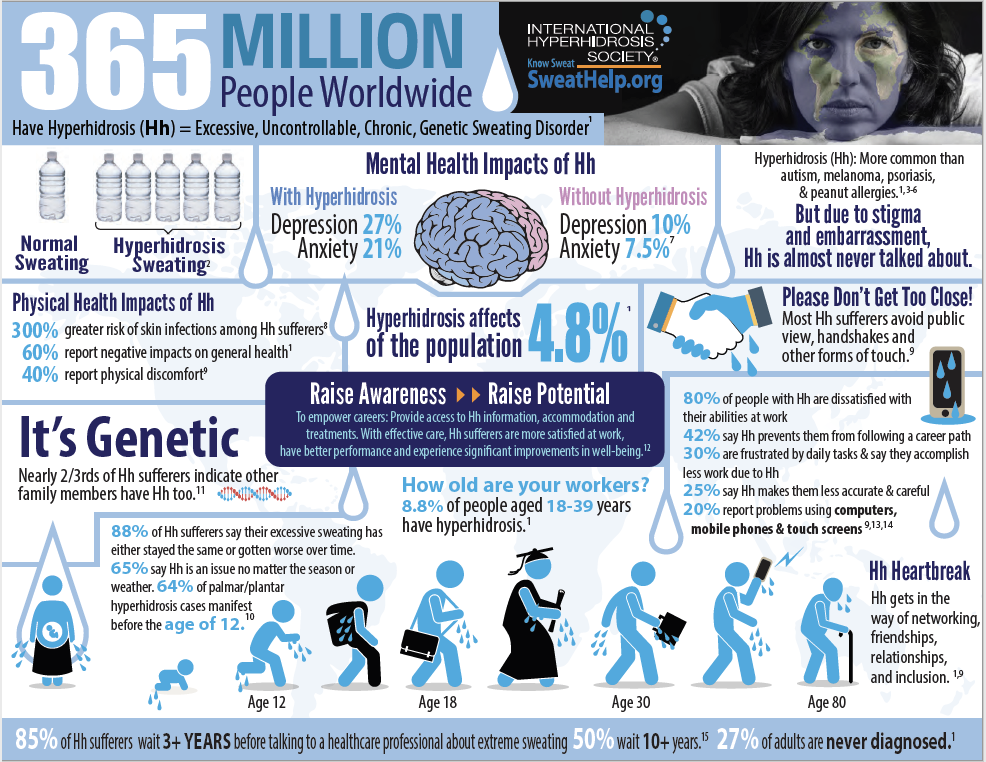
Paving a Way for Hyperhidrosis Accommodations in the Workplace
in 2017, in a move towards becoming more hyperhidrosis-friendly, AT&T started to think about potential sweat-related accommodations at work.
This was the beginning of some company efforts to help hyperhidrosis sufferers (including those interested in science, technology, engineering and math/STEM careers) to feel more valued and empowered to succeed – despite excessive sweating. Along the way, the International Hyperhidrosis Society has provided information, expertise and insights on behalf of hyperhidrosis sufferers in workplaces worldwide.
Power in Numbers
With over 230,000 employees around the globe, AT&T likely employs at least 12,000+ hyperhidrosis sufferers -- who could probably be more productive, creative and happy with appropriate workplace adjustments, equipment and support.
In a recent study, 8.8% of 18-39 year olds were shown to suffer from hyperhidrosis. That’s a lot of people impacted by extreme sweating during prime career-advancement years.
To help workers all over the world, the International Hyperhidrosis Society is encouraging other companies to become more hyperhidrosis friendly (contact us to learn how). When top-level management makes the effort to look deeper into the definition of diversity and accommodations, more employees with “invisible” medical conditions can succeed and thrive – and that’s good for everyone.
Does Sweat Impact Your Ability To Work?
If it does, you’re not alone and we hear this all the time. Indeed, hyperhidrosis:
- Causes problems in offices with computers, phones, other tech tools, and even paper
- Hurts salespeople who need to shake hands and look “sharp"
- Prevents healthcare workers from being able to easily don gloves and examine patients
- Can add a layer of danger to manual labor
- May force students and prospective employees to avoid STEM careers because hyperhidrosis and tech tools don't mix. Given the importance of opportunities in STEM, this is certainly a career field we need open to Hh sufferers, too.
Lisa J. Pieretti, Executive Director and Co-Founder of IHhS, notes that, “The pressures of dealing with hyperhidrosis in the workplace and around peers can be catastrophic to self-esteem and more. Too often, people become anxious about going to work, socializing with the boss or other associates, or being out in public in general. But when those with hyperhidrosis receive support, understanding and appropriate treatment, their lives can be dramatically changed. We’re thrilled to work with companies to help affected staff members.”
Ready to learn more about how hyperhidrosis impacts working-age adults and what can be done to help?
- Check out the infographic below full of key statistics and facts related to hyperhidrosis and work.
- Watch for additional information and programs in 2019 on Hh-friendly workplaces, and how we can ensure there are more of them.
- Peruse our website for details on current treatment options (from Botox to iontophoresis and from medications to wipes).
- Use our Physician Finder to help employees locate healthcare providers who are hyperhidrosis-friendly.
- Read our message to employers.
10 Small Tips for a Big Difference at Work
- Consider non-contact ice breakers for team-building activities.
- Avoid the handshake as a common gesture for initiating interviews – this leads to unnecessary anxiety for many hyperhidrosis sufferers.
- Allow for time and space to change clothing as necessary.
- Provide fans and air conditioning, as needed.
- Use breathable and quick-drying uniforms, office furnishings and technology accessories.
- Ensure your employees’ insurance plan covers hyperhidrosis as a medical condition necessitating treatment.
- Provide readily-available drinking water because hyperhidrosis sufferers can sweat five times more than what’s traditionally considered “normal."
- If someone in your workplace has excessive sweating, empower them to take advantage of their options and to not be ashamed.
- Lead the way: share this initiative with your employer and peers and get the conversation going.
- Reach out to IHhS for more information about how you can bring hyperhidrosis awareness and accommodations to your workplace.
Hyperhidrosis Awareness Month programs were made possible by unrestricted grants from the makers of Certain Dri, from Dermira and from the makers of miraDry.
Download Hh Work Impact Infographic here
